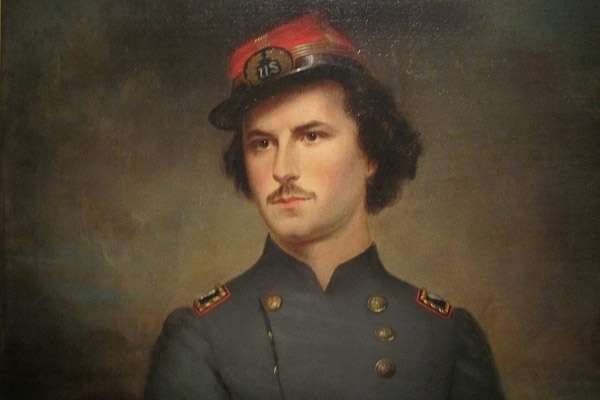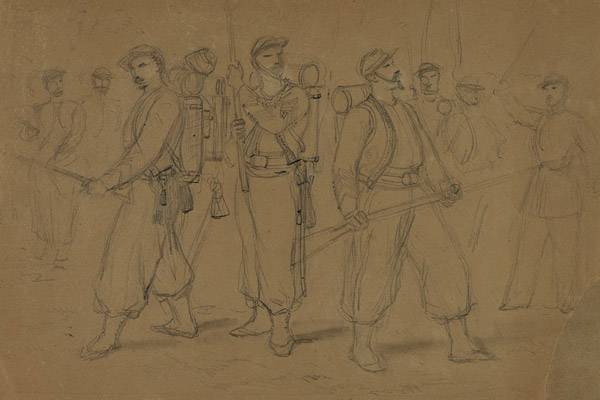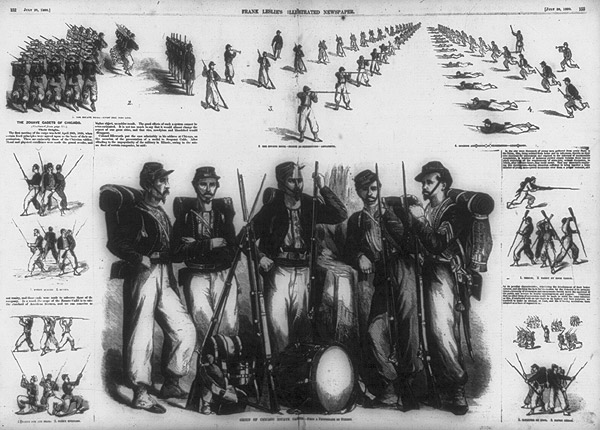
Earlier this week I got interested in the long shadow of American militias over America's gun laws and its culture of violence One of the men most responsible for the high regard in which militias were once held was a Chicagoan, and one of the singular figures in American history: Elmer Ellsworth, a young Union officer. The best modern-day comparison I can think of is Pat Tillman, a handsome, intelligent athlete who became a symbol in the defining conflict of his generation… only Ellsworth also became a sex symbol, a close friend of Abraham Lincoln, and a national star. They ended when Ellsworth was turned into a martyr of profound effect on the Civil War.
Ellsworth grew up in poverty in upstate New York, in the area north of Albany along the Hudson, the son of a door-to-door oyster salesman. He was a military obsessive from a young age, perhaps from early exposure to cadets en route to West Point; he organized his first "militia," the Black-Plumed Riflemen of Stillwater, as a young boy, and before the days of cowboys and Indians, played games of Americans and Redcoats.
Somehow, the young Ellsworth ended up in Chicago, where he found a community of similar enthusiasts, the Cadets of the National Guard. In 1861: The Civil War Awakening, Adam Goodheart writes: "Today, in an era of full-time, highly professionalized national armed forces, it is hard to appreciate the vastly different culture of the nineteenth century, when for most Americans, volunteering for military service was more like joining a weekend bowling league than enlisting in the army as we know it." The popularity of these waxed and waned, but the Mexican War increased their popularity and seriousness, just as Ellsworth arrived in Chicago.
Ellsworth first shows up in the Chicago press in 1857; the 20-year-old had gotten the support of the city's insurance bigwigs to organize and lead a fire bridgade, just a couple weeks after the biggest fire in the city's history (23 were killed), and a year before the city got its first paid fire department. Two years later, he showed up again in the Tribune with yet another request for able-bodied men:
The U.S. Zouave Cadets were awarded a stand of champion colors by the United States Agricultural Society, at their Seventh Annual Fair, which any military company in the United States or Canada, or the militia or regular army, are welcome to—if they can win them. For terms of drill, &c., apply immediately to
Col. E. E. Ellsworth
Commandant of Cadets

"Ellsworth's Chicago Zouaves," Alfred R. Waud, 1861
In the meantime, Ellsworth had met Charles De Villiers, a veteran of the French Zouaves who served eight years in Africa and, by the time Ellsworth came to Chicago, was a fencing instructor in a Chicago gym. Ellsworth, with his endless interest in anything involving uniforms and drilling, learned the dashing ways of the Zouaves—"a miraculous transformation," Goodheart writes, in which "the threadbare clerk became an expert fencer, gymnast, and drill instructor." His new skills allowed him to turn the boring Cadets of the National Guard into something like a militaristic version of the Jesse White Tumblers, as the Tribune editorialized in "The Zouave Furore":
When our Zouaves go through their splendid manual, in a three-hours' drill, with a precision like clockwork, moving limbs and pieces as if each was a part of a complicated and nicely adjusted machine, when they come swooping down in a gallant charge of bayonet, or to follow their complex evolutions in perfect harmony of movement, they elicit more than the admiration of ladies clapping their delicately kidded hands. Grim old military men allow their features to grow sunny with delight, and the marvel initiated by the young volunteer soldiers of Chicago, is accepted and praised by all.
In early 1859, Ellsworth began with 15 Zouaves. Within a year, the Trib later—but not, sadly, very much later—memorialized, "the young officer developed and made practical a system of tactics that will ever be associated with his name." The furore went on the road; just a year after Ellsworth could only brag of ag-fair accolades, the Zouave cadets were greeted on their return with a parade and an address by the mayor, even though their train arrived three hours late, pushing the celebration back to 10 p.m. Mayor Wentworth welcomed them home:
The citizens of Chicago cannot monopolize an interest in the result of your excursion. You have given a fresh impetus to the volunteer militia system, and touched a chord in the hearts of our citizen soldiers which will never cease to vibrate so long as freed shrieks for volunteers and and tyranny fortifies itself with regulars—so long as man as an individual struggling for equality with his fellow-man shall be arrayed against man as a mere machine wielded by the band of despotism.
Ellsworth was a star. Women wanted him, and men wanted to be him: "school-girls dreamed over the graceful wave of his curls, and shop-boys tried to reproduce the Grand Seigneur air of his attitude," Lincoln's secretary, John Hay, wrote. Goodheart goes even further: "Just a few years earlier, an English inventor had created the first photographs that could be reproduced in large numbers from single negatives. Now Ellsworth became the first pinup in America's—perhaps even the world's—history."

"The Zouave Cadets of Chicago," Frank Leslie's Illustrated Newspaper, 1860
The young Zouave would rise even further. His skills and charms had an effect on his elders as well, and in that same busy year of 1860, Ellsworth became Paymaster General of the Illinois State Militia, moved to Springfield, befriended Abraham Lincoln (Goodheart calls it a "schoolboyish crush"), and went to work as his law clerk. Paperwork and the study of law proved less compelling to Ellsworth than stumping for the presidential candidate, which the colonel brought all his looks, charisma, and organization to.
After helping his powerful mentor get elected, Ellsworth had yet more clout, and he channeled it into a grand synthesis of his dreams—whipping New York's rough fire bridgades into the "Fire Zouaves" and leading them into the Civil War. He got his wish. In April 1861, Ellsworth formed his militia; on the 29th, Ellsworth led the regiment, 1,200 strong, out of New York; on May 23rd, Virginia seceded; on May 24th, the Fire Zouaves marched on Alexandria, and Ellsworth went to take down the rebel flag from an inn, one that could be seen with a spyglass from the White House:
At the Marshall House, Barber adds, “Colonel Ellsworth just happened to meet the one person he didn’t want to meet”—innkeeper James Jackson, a zealous defender of slavery (and, says Barber, a notorious slave abuser) with a penchant for violence.
Ellsworth approached the inn with only four troopers. Finding no resistance, he took down the flag, but as he descended to the main floor, Jackson fired on Ellsworth at point-blank range with a shotgun, killing him instantly. One of Ellsworth’s men, Cpl. Francis Brownell, then fatally shot Jackson.
At 28, Ellsworth was dead, the first officer killed in the Civil War. "In size, in years, and in youthful appearance, a boy only, his power to command men, was surpassingly great– This power, combined with a fine intellect, an indomitable energy, and a taste altogether military, constituted in him, as seemed to me, the best natural talent, in that department, I ever knew," Lincoln wrote in memorial to his parents.
Killed in a moment of impetuousness, it was not Ellsworth's tactics that would outlive him: "it was perhaps Ellsworth’s death, even more than the attack on Sumter, that made Northerners ready not just to take up arms, but to kill."
Photographs: Wikimedia Commons, Library of Congress


